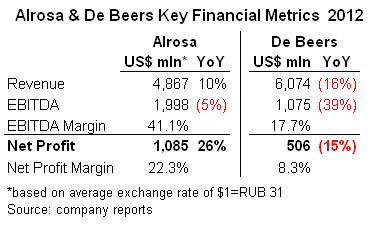Alrosa: We'll Be Number One in 2018
May 23, 13
A seven-hour flight from
Walking through this massive plant, which digests 1.7 million tons of ore annually from the open pit diamond mine, 24 hours a day, 7 days a week, brings you much closer to the hard work needed to make Alrosa the largest diamond producer by volume. In Yakutia, 34 million carats of them are mined annually.
However, it was back in Mirny, some 600 meters underground, at the Alrosa International underground mine where I felt that I was truly in the heart of the beast. Standing next to the electric roadheader mining machine as it ground the diamond-bearing kimberlite mine wall was as far from the romantic and glamorous aura of polished diamonds as this frozen harsh environment of Siberia was from 5th Avenue.
The strict safety procedures, the darkness, heavy air and bleak setting of the mine are far removed from the high-end perception of diamond jewelry. This is the future of many of Alrosa's diamond mines, as it's extending their life by going underground, while also maintaining their efficiency, measured as net profit versus operational expenses, according to Alrosa First Vice President Executive Director, Igor Sobolev.
Alrosa sits on a massive 1.154 billion carat proven reserve in
On the eve of its IPO, planned for October this year, the company is moving forward with an aggressive plan to rid itself of its non-core businesses. According to Sobolev, this includes selling its hydropower station, gas, oil and agricultural companies. A few other assets have already been sold, including the Timir iron ore operation and its small chain of hotels, which were bought a few weeks ago by a company from
Alrosa has an aggressive plan to be the world's largest diamond mining company, overtaking De Beers. As part of this strategy, Alrosa is recommending that its two main shareholders,
Russia and Yakutia will each offer a 7-percent stake in the company in the IPO. However, selling non-core assets and transferring services to the government is not where the growth will come from.
In addition to the large reserves it has in
All this is taking place while De Beers is reducing production and investing in retail operations that apparently are not improving its profitability. Today, De Beers mines fewer carats than Alrosa, but generates a larger revenue. This is mainly due to Alrosa choosing to extract smaller goods from the ore than De Beers does. Despite this, Alrosa was twice as profitable as De Beers in 2012 with "a higher operational efficiency than the competitors," Sobolev said. Following is the comparison:

I asked Sobolev when Alrosa plans to be the largest diamond company. "By 2018," he said without hesitation. This is clearly a well thought-out plan. It is based on constant consumer demand, an increase in production, known reserves and rough diamond prices increasing moderately, by a few percent annually. This plan is not based on growing consumer demand or unproven resources.
Later this year, Alrosa will start testing remotely-operated mining equipment to reach areas it hasn't previously mined due to safety concerns. Its long-term strategy is no less far-reaching and determined. They'll get to places they've never been before, but it leaves one very important question open: as it becomes number one, will it also assume the leadership role the diamond industry needs so desperately?
Follow Edahn on Twitter
Get in touch on LinkedIn
Connect on Facebook
Or email eg at edahngolan dot com